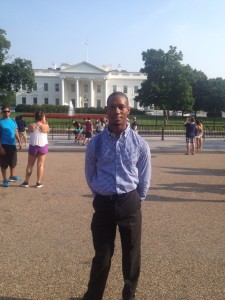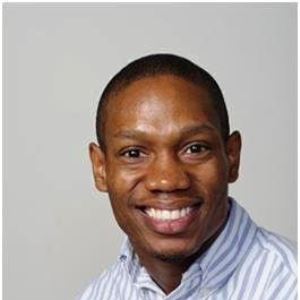Jerry Robinson is a summer intern at United Cerebral Palsy. He is a Ph.D. candidate at Syracuse University. His research explores the “life-hacking” practices of individuals with physical disabilities. Jerry also has cerebral palsy.
Whenever I reflect on my early experiences as an individual with a disability, the first thing that comes to my mind is how much of it was shaped by other people’s perceptions. Do not get me wrong; the impairment related aspects of cerebral palsy also played a major role in my growth and development. Nevertheless, in some ways the negative assumptions that others made about me because of my mobility, speech, and dexterity impairments impacted me to a greater extent than CP itself.
I spent the first three years of my elementary school education in a school specifically for children with disabilities. I never really saw myself as different in this environment. Some of my friends used wheelchairs and others had walkers or crutches. I could walk without mobility aids, but my gait and balance were noticeably different from the “average” able-bodied person. Since everyone at my school had a disability, CP wasn’t anything extraordinary. Although we were diverse in terms of the type and severity of our disabilities, we respected and appreciated each other in spite of our differences. Unfortunately, this was not the case once I transitioned to my new school with mostly able-bodied kids.
I repeated the second grade once I transitioned to my new school. Here I developed an acute awareness that I was different from my peers because they pointed it out quite often. Although I did not experience a lot of overt bullying once I transitioned to my new school, I was teased at times. I also experienced a lot of the social isolation and rejection that bullying victims feel. Many of my classmates stared at me and asked questions that reflected their lack of understanding. Some of them were afraid to touch me because they thought I had a contagious disease. I had to use assistive technology, which simultaneously allowed me to demonstrate my capabilities and made me the target of unwanted attention. I also had to wear a hockey helmet because I used to fall a lot and needed something to protect my head. Needless to say, the helmet attracted unwanted attention. Additionally, I had trouble keeping up with everyone else in my class. All of these issues made me very self-conscious. I desperately wanted to fit in with my peers, but everyone kept focusing on the fact that I was different.
As a second-grader, I was naïve to the fact that social factors shape experiences just as much as impairment-related ones do. As a result, I perceived certain negative interactions with my peers as indicators of some deficiency in me. As an adult, I sometimes find myself saying that I was overly concerned about what my peers thought of me back then. Although there is some truth in that statement, it minimizes the complexity of my transition. I was simultaneously learning how to adapt to a new physical environment as an individual with a disability and trying to penetrate social barriers that were foreign to me hitherto. I had assistive technology that enabled me to overcome physical barriers. I was blindsided by the social barriers, however, and I had no idea how to overcome them.
Although it took a few years for me to adjust to my environment, make friends, and feel somewhat accepted, I eventually did. Nevertheless, those early experiences impacted my sense of self-worth as an individual with a disability. I was content with who I was as an individual before the transition. Various experiences at my new school made me feel inadequate and left me wanting to minimize my impairments so that I could project an image of “normalcy”. Most children struggle with trying to fit in with their peers to some extent. As I look back over my childhood and young adult experiences, however, I realize that I internalized the uninformed opinions that my able-bodied peers had regarding disability.
The medical model, social model, and charity model are three very different ways to think about disability. Although all three models bear on my experiences as a person with a disability, the medical and social models are most relevant to my childhood experiences. The medical model says disability is inherent in the individual and makes him or her deficient. People and institutions that embrace the medical model attempt to make individuals with disabilities “normal” (i.e., like able-bodied individuals) rather than embracing them for who they are and what they bring to the table. The medical model focuses solely on impairment and therefore somewhat diminishes the inherent value and worth of people with disabilities. The social model of disability, on the other hand, says that people are disabled by mindsets, systems, and structures that exclude them. Social model proponents say disability is not the result of an impairment. Instead, disability is the result of systems, structures, and mindsets that exclude people based on their impairment. Many people view disability through the lens of the medical model.
| Model | Description | Implications |
| Medical | Disability is associated with incapacity, functional loss, and deficiency | Disability is defined in terms of an individual’s impairment status only. It is something to be minimized or cured. Able-bodied people are normal and individuals with disabilities are less than normal. Medical professionals always know what is best. |
| Social | Disability is caused by exclusionary mindsets, systems, structures, and objects | Disability is defined by prevailing social norms. It is something that should be accommodated and accepted as a normal part of life. Society needs to change rather than individuals with disabilities conforming to able-bodied norms |
| Charity | Disability is associated tragedy. Individuals with disability are objects of pity and sympathy | Disability is seen as an immobilizer. individuals with disabilities are passive recipients of care who must be helped by others. They need special products and services that “normal” people do not need. Empowerment and self-determination are not important to individuals with disabilities |
Models of Disability
Honestly, I viewed myself through the lens of the medical model for a long time. It wasn’t until I learned about the medical and social models that I realized how much the former shaped my thinking as a child and young adult. Nowadays, I intentionally identify with the social model. The social model of disability resonates with me because it considers non-impairment related factors in the disability equation. I will not discuss the limitations of the social model here. Nevertheless, it provides a useful framework to understand my second-grade experiences. My peers focused on the fact that I was visibly and audibly different from them. It is true that I was different in terms of certain abilities. However, I was just like them in several other ways. For instance, I had the same desire to fit in and feel accepted. I took the same classes and completed the same work as my peers. I had the same scholastic aptitude. Nevertheless, my impaired speech, impaired mobility, and assistive technology utilization carried more weight than my actual capabilities and personhood. This is precisely what made disability a source of frustration for me. My perspective was ignored because I was not “normal” (i.e., able-bodied).
Instead of learning to accept myself, I internalized the inferiority that my peers projected onto me. It is one thing when your peers view you as deficient because you have a disability. It is something altogether different when you look down on yourself because you have a disability. As a young person, I internalized wrong ideas about disability. These ideas were not grounded in my lived reality. Instead, they were shaped by culture, media, my classmates, and even well-meaning but uninformed adults.

Unfortunately, sometimes humans ignore and/or misrepresent the perspectives of other humans. A person who is unfamiliar with someone’s capabilities and life experiences can assume things about that individual. Children do this quite often, but adults can do the same thing. This is likely to happen whenever there are able-bodied individuals who see disability as an impairment issue only and are unwilling to question this view. This is why there will always be a need for individuals with disabilities to fight to be heard, understood, and respected. Children with disabilities can feel disillusioned when they initially encounter people who make incorrect assumptions about them. I learned this for myself in the second grade where my peers projected their medical model-informed views of disability on me. It is frustrating when people make assumptions about you that do not reflect your lived experiences, potential, and capabilities. However, it is important for individuals with disabilities to learn to identify other people’s assumptions and run them through the filter of their actual experiences and capabilities. This is the key to self-acceptance when you have a disability. Once you know that your impairments do not define you, then you are free to be your whole authentic self instead of trying to live up to someone else’s standard of normalcy.
My story is not unique. If you are a parent of a child with a disability, the chances are that your child may wrestle with identity and self-acceptance at some point. Although I am not a parent, I would like to offer a few words of encouragement to anyone who has a child with a disability. What your child thinks about himself or herself can shape the course of his/her life. Although children with disabilities cannot always stop other people from making wrong assumptions about them, they do not have to be imprisoned by perspectives that are uninformed by their actual experiences, capabilities, and potential. One of the best things you can do for your child is help him or her to develop a healthy sense of self-worth. Children who learn to accept themselves will more than likely become adults liberated from opinions of others. That sense of self-worth will empower them to live lives that are authentic, self-determined, and personally fulfilling to the greatest extent possible.
